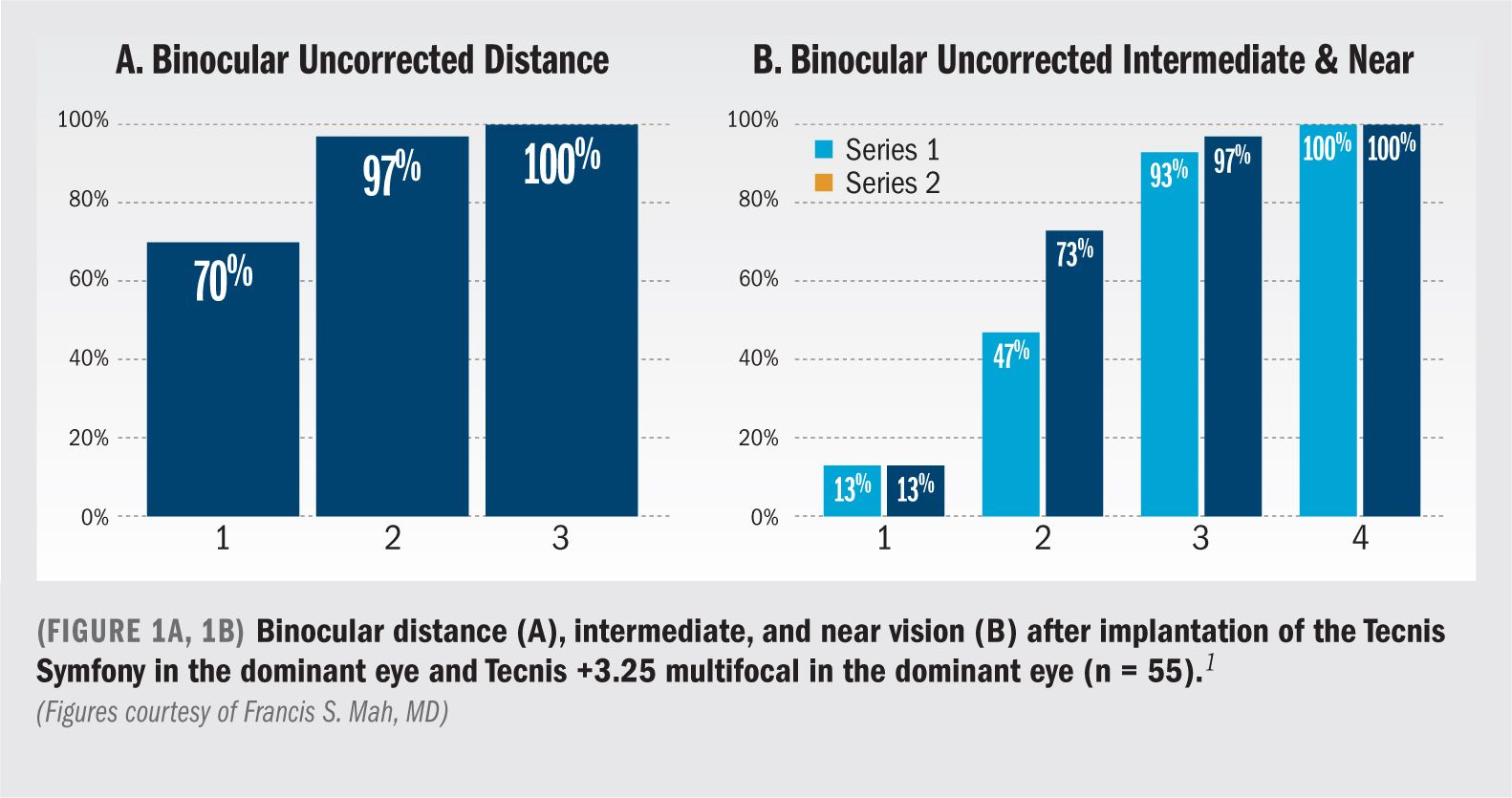News
Article
Personalizing refractive outcomes with presbyopia-correcting IOLs
Author(s):
EDOF, multifocal IOLs providing options for patients with range of visual needs

Personalization is a useful procedure for maximizing the benefits of today’s advanced IOL technologies.
Innovations in IOL technology enable refractive-cataract surgeons to deliver near, intermediate, and distance vision, reducing spectacle dependence in presbyopic patients. However, in my experience, personalization of lens selections can further optimize results and maximize patients’ range of vision to meet their visual needs. During the past five years, I have performed personalized IOL implantations, balancing the benefits of different lenses.
I initially mixed and matched +2.75, +3.25, and +4.0 multifocal IOLs (Tecnis ZKB00, ZLB00, and, ZMB00 respectively, Johnson & Johnson Vision). When extended depth-of-focus (EDOF) IOLs were introduced, I began incorporating those into personalization (Tecnis Symfony, Johnson & Johnson Vision). I now have about 200 patients (400 eyes) with either bilateral Symfony lenses or a Symfony plus a different lens in the fellow eye.
Personalization strategies
In my practice, 40% of the IOLs I implant are premium IOLs. One-quarter of those are toric, while 75% of the premium IOLs are multifocal (ZKB00, ZLB00. ZMB00), pseudoaccommodative (Crystalens or Trulign, Bausch + Lomb), and Symfony IOLs (both toric and nontoric).
I personalize at least half of these cases. We explain to patients that they may receive two different lenses, and I think they appreciate that we can fine-tune their vision with this technique. Depending on preoperative refraction, reader prescription, or glasses add, I discuss with patients what I feel would be best for them.
For example, if a patient has +2.75 add in glasses, or is a –3.00 myope, I will recommend a ZLB00 (+3.25 add at IOL plane). Otherwise, I usually implant a Symfony in the first eye. If the patient is satisfied with both distance and near, I will implant the same lens in the fellow eye. If stronger near vision is desired, I may implant a ZLB00 in the other eye.
I have had good outcomes when I place the Symfony in the eye that has astigmatism and then implant the multifocal in the eye with less astigmatism. This reduces the need for astigmatic keratotomy or limbal relaxing incisions. Interestingly, I find that eye dominance does not matter as much as it might seem. Whether the dominant eye has the lower-add IOL, or the nondominant eye has the more distant-dominant IOL really does not seem to matter.
Thus far, I have not had any unhappy patients with this approach. With EDOF lenses, both eyes get the benefit of good distance vision, and eye dominance is less of a factor for the near eye. A recent paper demonstrates the efficacy of combining an EDOF and mid-add multifocal.1
In 55 patients with this combination, binocular uncorrected distance visual acuity was 20/16 or better in 70% of patients and 20/20 or better in 97% (Figure 1A). Binocular intermediate and near visual acuity both 20/25 or better in almost all patients three months after surgery (Figure 1B).
There are patients in whom I will opt for a mid-add multifocal in the first eye. For example, if the patient is quite short in stature, has an unusual hobby, or expectation of intensive near work, I may start with the multifocal in the first eye. In patients with -2.00 D or more of myopia, I also begin with a mid-add multifocal in the first eye because these patients are accustomed to reading up close without their glasses.
In rare cases, I do still implant multifocal IOLs in both eyes. For example, in a recent case I implanted a mid-add multifocal in the first eye of a relatively short, female engineer. She was still dissatisfied with her reading ability, so I implanted the ZMB00 in her fellow eye, after a discussion about the higher risk of glare and halos.
The patient was happy with the outcome; with the combination of mid- and high-add multifocals she could easily see the computer and read. With the array of available lens options, I am much more comfortable offering presbyopia-correcting IOLs to my patients. Not only do I feel confident that I can achieve the spectacle independence they are seeking but I also know that if there is any dissatisfaction after the first-eye surgery, I have options to get the patient to 20/happy.
Laying the groundwork
With advances in lens technology, it is important to keep in mind that patients may require more chair time and discussion about options. Patients are very smart and want to participate in decisions regarding their healthcare. It is rewarding to have higher-level discussions with patients, so they understand the process. I also believe they are ultimately more satisfied and may be more understanding if the outcome is not exactly as they expected.
We remind patients they do not have 20-year-old eyes and that our lens options have limitations, but we can decrease their dependence on glasses and contact lenses. I also explain that with multifocal and EDOF lenses, they are more likely to notice glare and halos in dim lighting situations. It is critical to optimize the patient’s ocular surface before performing measurements. The tear film affects biometry, postoperative vision quality, and, ultimately, patient satisfaction.
Patient selection
Hyperopes and emmetropes are generally the easiest candidates to start with for personalization and for presbyopiacorrecting IOLs in general. We also need to assess patients’ personalities. Patients should be relaxed, while understanding that there are limitations. I encourage monovision patients to continue with monovision because it is familiar to them.
I may not be as likely to use personalization in –2.00-D, –3.00-D, or –4.00-D myopic patients unless they have worn multifocal contact lenses and understand that distance correction reduces reading vision. In any case involving a premium lens, biometry measurements, axis determination, and IOL power calculations must be meticulous. I prefer the Barrett Universal, Barrett Toric, and Barrett post-refractive calculator (www.ascrs.org).
I also find the ORA System with VerifEye (Alcon Laboratories) to be helpful for intraoperative confirmation of the IOL power especially in post-refractive cases, long eyes, or short eyes.
Target refraction
When implanting multifocal IOLs, I aim for an outcome as close to plano as possible, but I target -0.20 D with Symfony lenses, which has been successful in my hands. I have not found it helpful to aim for a more myopic target with a Symfony lens in the nondominant eye; my preference would be to opt for a mid-add multifocal if better near is desired.
It is important to reduce astigmatism as much as possible during the procedure, although I have been surprised by how much astigmatism patients actually can tolerate, especially with EDOF lenses. Personalization is a useful procedure for maximizing the benefits of today’s advanced IOL technologies. All of my patients who have had personalization are satisfied with their vision and have said that they would do it again.
Disclosures:

Francis S. Mah, MD
P: 858/554-7996
E: Mah.Francis@ Scrippshealth.org
Dr. Mah is director of Cornea and External Diseases and co-director of Refractive Surgery at the Scripps Clinic Torrey Pines in La Jolla, CA. He is a consultant to Alcon Surgical, Bausch + Lomb, and Johnson & Johnson Vision.
References:
1. Black S. A clinical assessment of visual performance of combining the Tecnis Symfony extended range of vision IOL (ZXR00) with the +3.25 D Tecnis multifocal 1-piece IOL (ZLB00) in subjects undergoing bilateral cataract extraction. Clin Ophthalmol. 2018;12:2129-2136.
Newsletter
Don’t miss out—get Ophthalmology Times updates on the latest clinical advancements and expert interviews, straight to your inbox.





